 | ||
An SSN is a nuclear-powered general-purpose attack submarine. SSN is the US Navy hull classification symbol for such vessels; the SS denotes a submarine and the N denotes nuclear power. The designation SSN is used not just in the United States Navy (USN), but throughout NATO under STANAG 1166.
Contents
History
The first nuclear-powered attack submarine was the US Navy's USS Nautilus, operational from 1954. This was followed by the four submarines of the Skate class entering service in 1957. The Royal Navy's first nuclear fleet submarine was HMS Dreadnought which by using an American reactor entered service in 1963. The first all-British nuclear submarines were the two Valiant-class submarines.
The USN submarine fleet has been all-nuclear powered for over two decades. The bulk of the USN's SSN fleet has been the Los Angeles-class attack submarine. Designed during the Cold War the Los Angeles-class boats' raison d'etre was to protect USN carrier battle groups and to hunt Soviet Navy SSBNs before they could launch a first strike against the United States.
The first ever major combat action involving an SSN was during the 1982 Falklands War. An Argentinian cruiser, ARA General Belgrano was sunk by torpedoes fired by the Royal Navy fleet submarine HMS Conqueror. After that incident, the Argentinian Navy was effectively confined to port.
Since the end of the Cold War, SSNs have evolved into multi-mission submarines. Their roles include submarine-launched cruise missile platforms, intelligence gathering platforms, insertion and exfiltration of special forces teams in addition to traditional hunter-killer SSN roles.
The advantages of an SSN over a conventionally powered SSK are much longer endurance (limited more by the crew than the boat, a nuclear submarine can stay submerged for months and does not need refueling in their 25-year lifespans), and higher speed. Unlike most SSKs, SSNs do not have to surface periodically for air, which would compromise their stealth. Some of the newest conventional submarines approach these advantages: Stirling engine powered vessels can cruise underwater for up to two weeks and, like diesel/electric vessels (and in theory LOX powered vessels), are significantly quieter than nuclear submarines, since they do not need to run the powerful (and noisy) pumps associated with the cooling circuits of pressurized water reactors.
The main disadvantages of an SSN are the technological challenges and expenses of building and maintaining a nuclear power plant. Nuclear submarines can have political downsides, as some countries refuse to accept nuclear-powered vessels as a matter of policy. Furthermore, decommissioned nuclear submarines require costly dismantling and long term storage of the radioactive waste.
The following navies currently operate SSNs:
Active and future SSN classes
Known as "fleet submarines" in the Royal Navy
